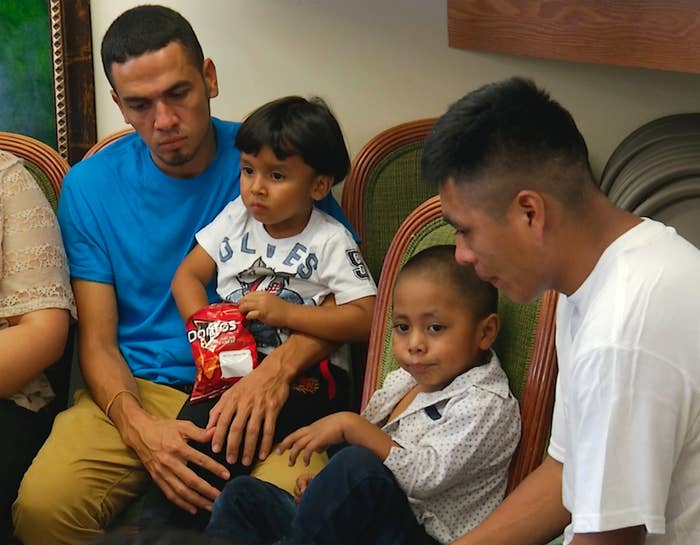
Some judges aren’t convinced the government will be able to meet a court-ordered deadline to reunite parents and children separated at the border by the end of the month.
In the past two weeks, two federal judges — one in Chicago and one in Washington, DC — ordered the administration to reunite separated parents and children who filed individual lawsuits, setting deadlines before the nationwide July 26 reunification deadline set by US District Judge Dana Sabraw. The judges rejected the Justice Department’s arguments that multiple orders would interfere with the administration’s reunification efforts, concluding that the harm suffered by separated children required immediate action.
The orders are a harbinger of litigation to come if the administration fails to meet Sabraw’s deadline. Karen Hoffman, a lawyer in one of the Chicago cases where a judge ordered faster reunifications, said more lawsuits on behalf of individual families are likely if the government has trouble reunifying the families covered under Sabraw’s order.
“If it becomes necessary we absolutely would file more complaints,” she said.
The judges in Chicago and DC pointed to the administration’s struggles in meeting Sabraw’s deadlines so far. In a July 9 opinion, US District Judge Edmond Chang in Chicago wrote that “the solidity of the government’s prior representations that the deadlines will be met has waned.” This week, US District Judge Paul Friedman wrote that any burden the government faced in complying with multiple reunification orders was “self-inflicted.”
The government has identified 2,551 separated children ages 5 to 17 in government custody who may be eligible for reunification with a parent under Sabraw’s order. The administration has already reunited several dozen children under age 5 under an earlier deadline set by Sabraw. Federal officials deemed a number of parents ineligible because of criminal histories, but also said they would need more time for reunifications because the parents had been released into the United States or deported, and the government was still trying to find them.
According to a reunification plan submitted by the Justice Department to the court, the administration is focusing its efforts initially on screening parents who are still in the custody of Immigration and Customs Enforcement. At a court hearing earlier this week, a Justice Department lawyer said that the Office of Refugee Resettlement, which manages the detention of migrant children, had cleared the detained parents of 1,317 children for reunification. The parents also need to be cleared by ICE — of those cleared by ORR, the parents of 918 children had been cleared for reunification by ICE, the parents of 51 children had not been cleared by ICE, and the parents of 348 children were undergoing reviews.
Earlier this week, Sabraw temporarily blocked the administration from deporting reunified families while he considers a request by the American Civil Liberties Union for a longer-term order restricting the government from immediately removing reunited families from the country.
The class action before Sabraw, who sits in San Diego, has been the primary legal vehicle for family reunifications, but more than a half dozen lawsuits on behalf of individual parents and children have been filed in federal courts across the country. In a case filed in Massachusetts, a motion for immediate reunification was withdrawn July 16, before the judge had a chance to rule, because the mother and her son were reunited.
Chang in his July 9 ruling ordered the government to reunite two families within 72 hours. He noted that in the California case, the government already had asked for more time to reunite families and had trouble meeting Sabraw’s deadline for parents who were released from ICE custody.
“In this situation, which all began with ‘a chaotic circumstance of the Government’s own making,’ ... it is appropriate to consider Plaintiffs’ request for reunification with a skeptical eye to the government’s prior representations,” Chang wrote, quoting from Sabraw’s June family reunification order.
Chang wrote that although all separated children were suffering, the lawyers for the two children in the case before him, referred to by the initials W.S.R. and C.D.A., presented evidence that they were facing “extreme irreparable harm.”
“It might be that many other sons and daughters of Ms. L. II class members would be able to compile the same record evidence if they had the lawyers and resources to do so. But the fact of the matter is that W.S.R. and C.D.A. have proven that every day of separation is causing dangerous harm to their mental health,” Chang wrote.
On July 18, US District Judge Paul Friedman entered orders in two different cases requiring the government to reunite two families who sued by July 20. Like Chang, Friedman pointed to the government’s difficulties complying with Sabraw’s order, writing that the July 26 deadline was “not guaranteed.” If the government had to commit more resources to reunification efforts in order to comply with multiple court orders, so be it, Friedman wrote.
“Given the gravity of the harm at issue, the need to expend resources cannot outweigh these threats to constitutional rights,” Friedman wrote. “The harm to defendants is self-inflicted: defendants embarked on a zero-tolerance policy, bringing misdemeanor charges and separating thousands of children from their parents, without a plan for reunification after the short, time-served sentences for improper entry into the United States.”
At least one judge has sided with the government and denied a request for immediate reunification. On July 13, US District Judge Victor Bolden in Connecticut ordered the government to take steps to provide trauma treatment for separated children, but said he would “avoid duplicating the California Order and the relief provided by that court.”
A Justice Department spokesperson declined to comment.

